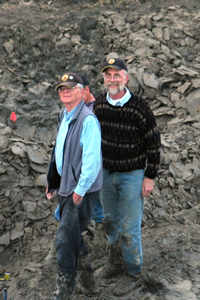 Holmes A. Semken, Jr. (left) is a retired Professor of Geology from the University of Iowa (PhD Geology, University of Michigan-Ann Arbor 1965; University of Iowa, 1965-1999). His research interests center on ice-age paleoecology, biogeography, evolution, and taphonomy via fossil rodents and insectivores–primarily those found in cave deposits. In order to measure the impact of post-glacial climatic change on the glacial biota and megamammal extinction, post-glacial sites are also excavated. Discovery of the Tarkio Valley giant ground sloth prompted Holmes to put his tweezers aside temporarily for the thrill of excavating large mammals. The Tarkio Valley specimen is actually his second experience with Pleistocene megamammals. In 1961/1962 he worked for the Smithsonian and collected parts of 23 Columbian mammoths at the Lamb Springs (Littleton) site in Colorado. Unfortunately, neither Lamb Springs nor the Tarkio Valley sites produced sufficient numbers of fossil rodents for meaningful interpretation. He will be looking for that ideal site when the Tarkio excavations are complete.
Holmes A. Semken, Jr. (left) is a retired Professor of Geology from the University of Iowa (PhD Geology, University of Michigan-Ann Arbor 1965; University of Iowa, 1965-1999). His research interests center on ice-age paleoecology, biogeography, evolution, and taphonomy via fossil rodents and insectivores–primarily those found in cave deposits. In order to measure the impact of post-glacial climatic change on the glacial biota and megamammal extinction, post-glacial sites are also excavated. Discovery of the Tarkio Valley giant ground sloth prompted Holmes to put his tweezers aside temporarily for the thrill of excavating large mammals. The Tarkio Valley specimen is actually his second experience with Pleistocene megamammals. In 1961/1962 he worked for the Smithsonian and collected parts of 23 Columbian mammoths at the Lamb Springs (Littleton) site in Colorado. Unfortunately, neither Lamb Springs nor the Tarkio Valley sites produced sufficient numbers of fossil rodents for meaningful interpretation. He will be looking for that ideal site when the Tarkio excavations are complete.
David J. Brenzel (right) is the co-principle investigator on the sloth project. He has a teaching certificate from Mount Mercy College (1992), an MBA-Finance from Indiana University (1979) and BA-Zoology from the University of Wisconsin (1974). He worked at the University of Iowa Museum of Natural History for 14 years serving as curator and education and outreach coordinator. In previous lives he was a teacher-naturalist at the Indian Creek Nature Center, an elementary school teacher and a Program Planning and Control manager at Rockwell-Collins in Cedar Rapids, IA. He lives on a small acreage, with his wife and accomplished sloth-digger Lynette, where they are growing a garden, a tall-grass prairie, a sloth park/arboretum of almost 300 different kinds of trees and shrubs, and too many deer. Holmes is the fossil expert; my training and experience are in biology and ecology. For me sloths are still very much alive. As we learn more about these amazing creatures I see their footprints everywhere–in the way they shaped the land, ecouraged specific plants and animals, and paved the way for settlement by humans.
